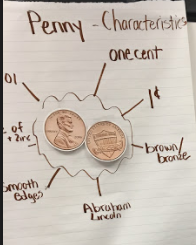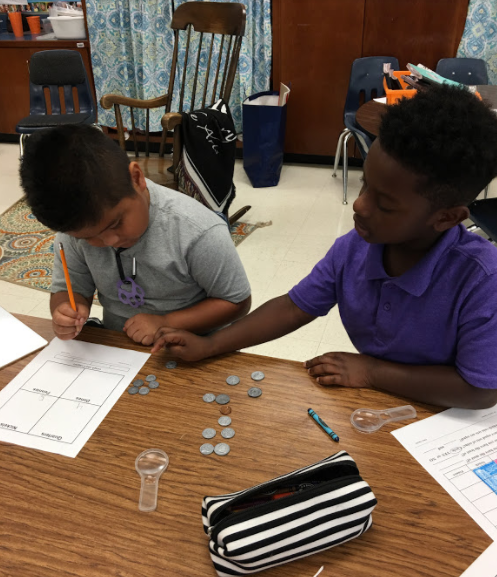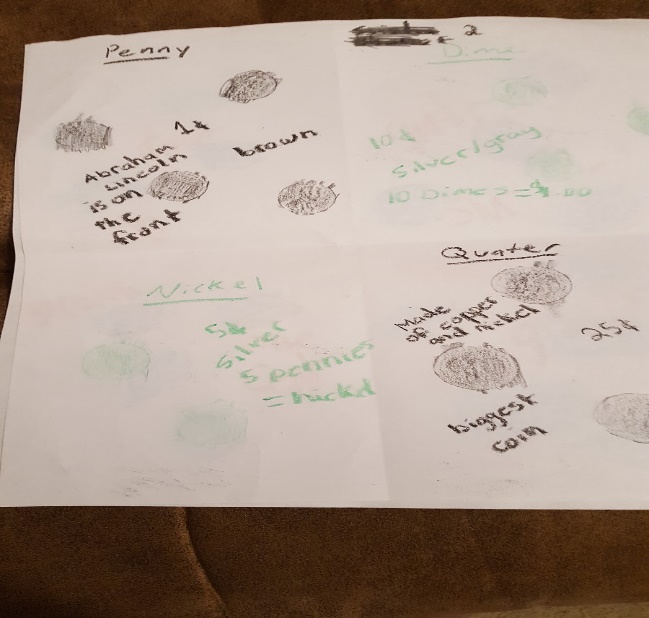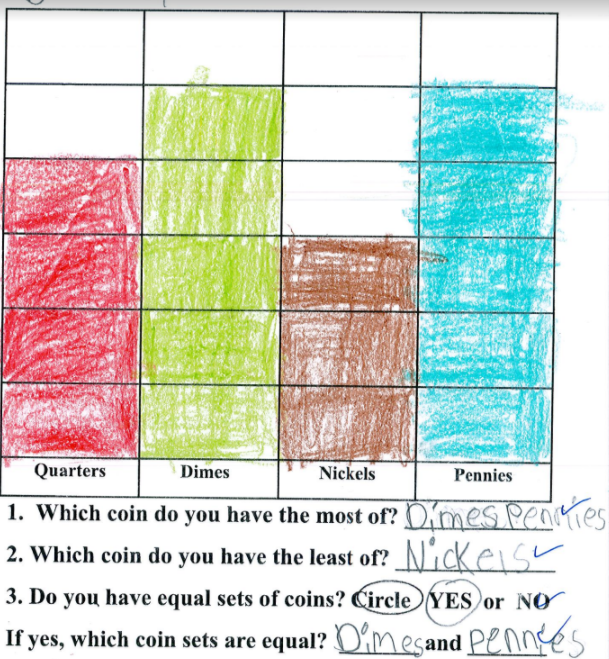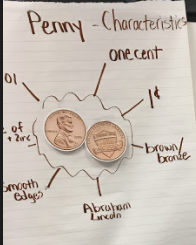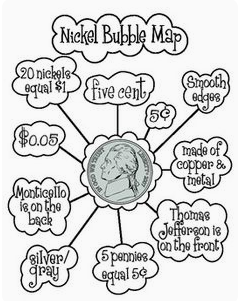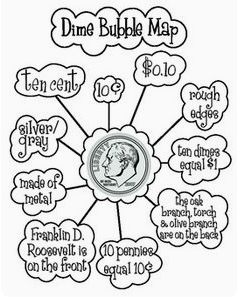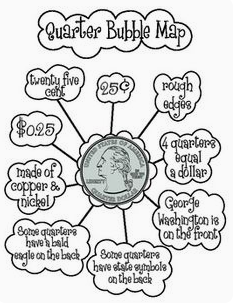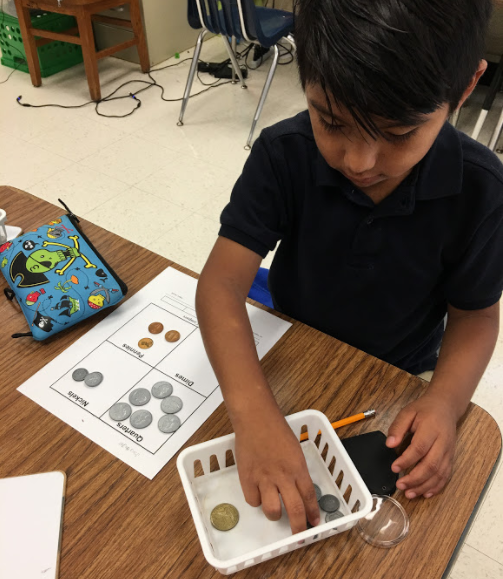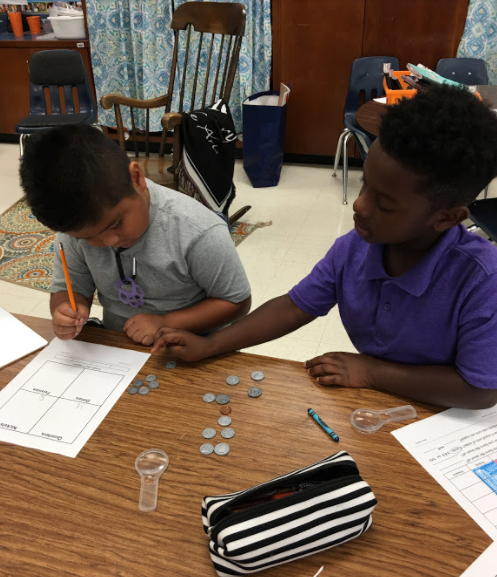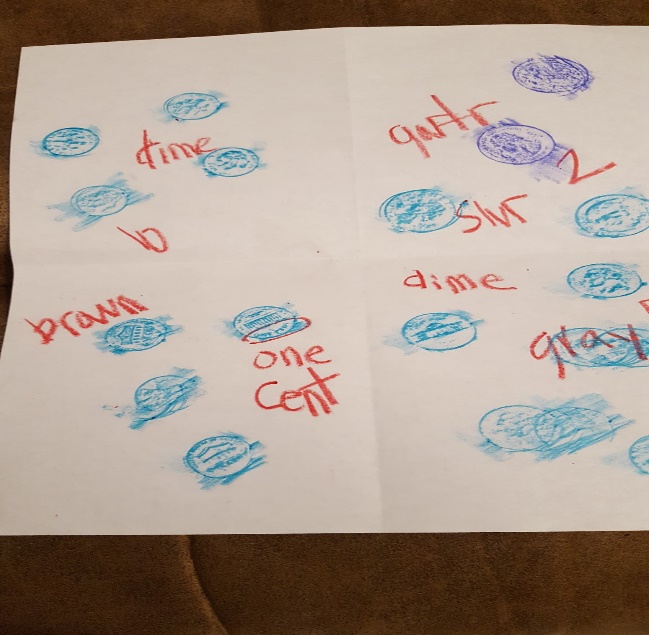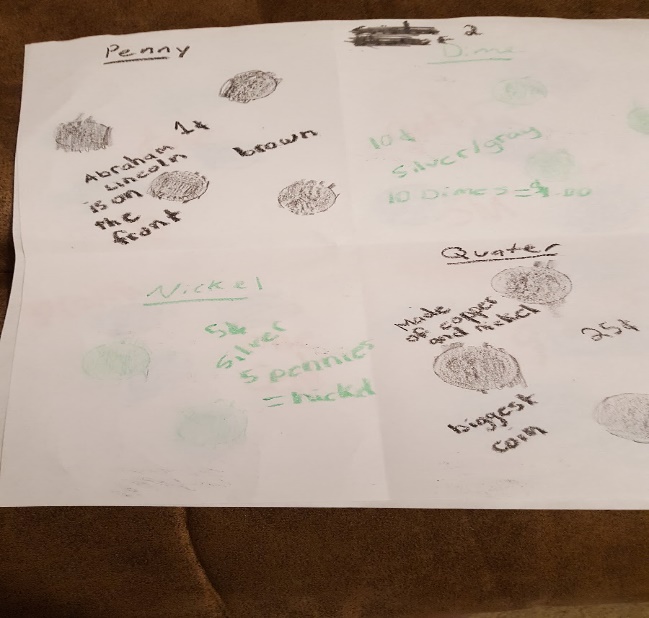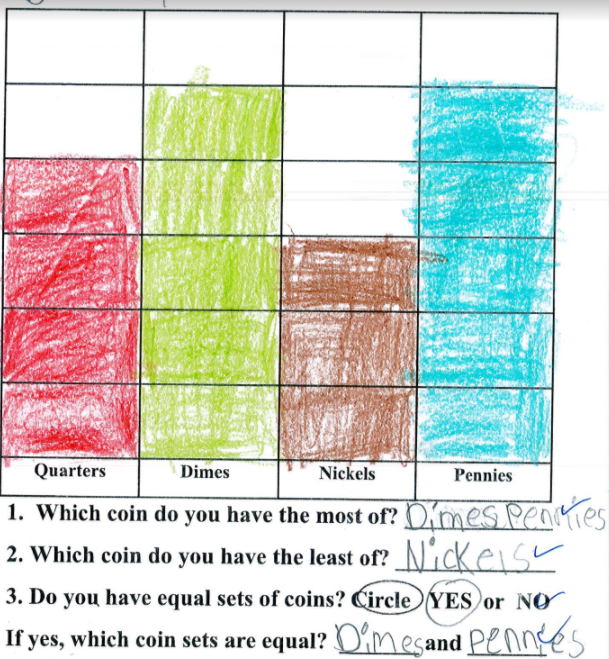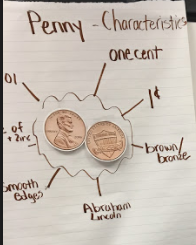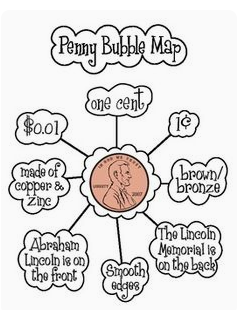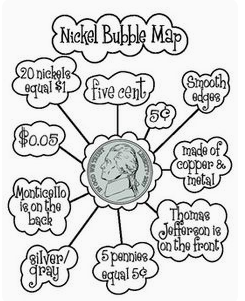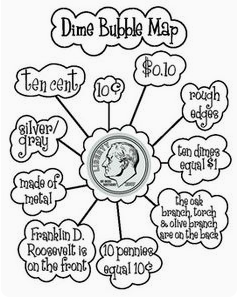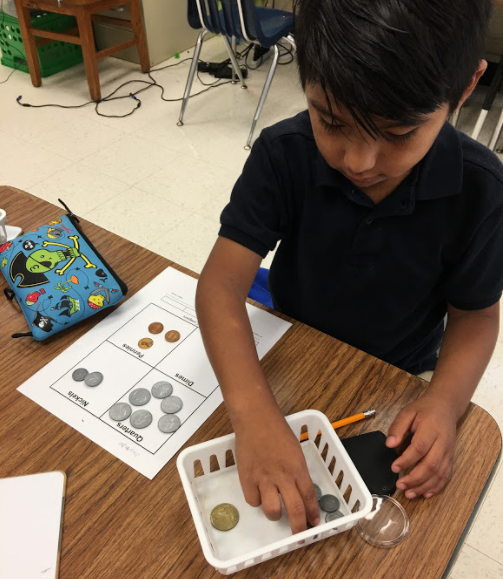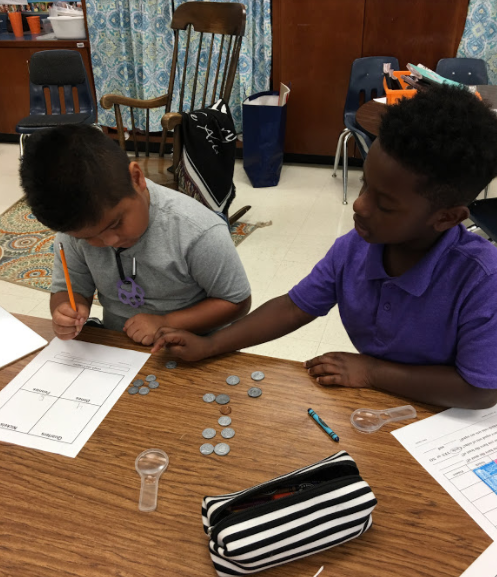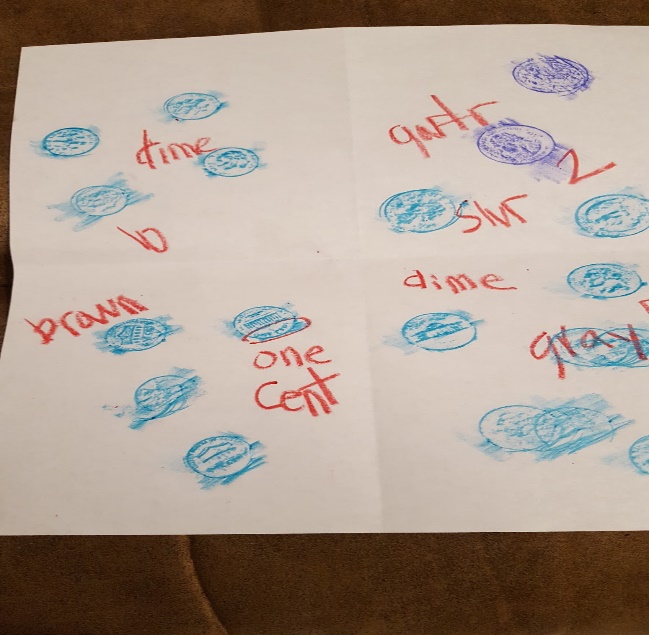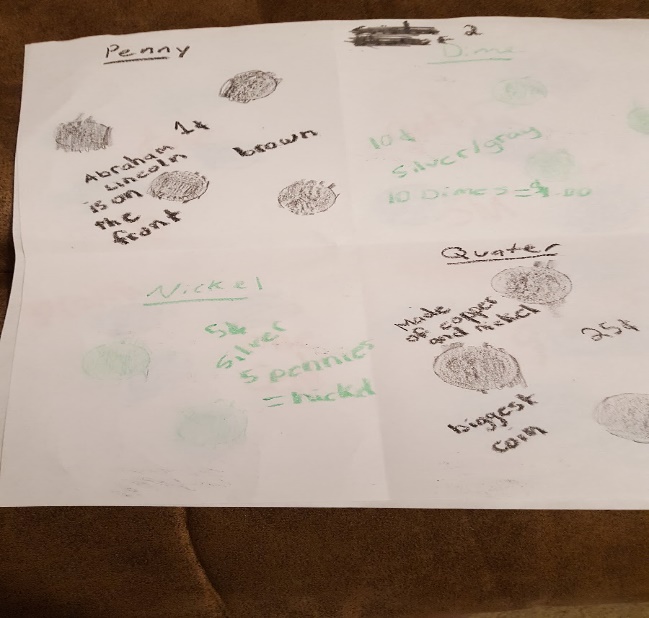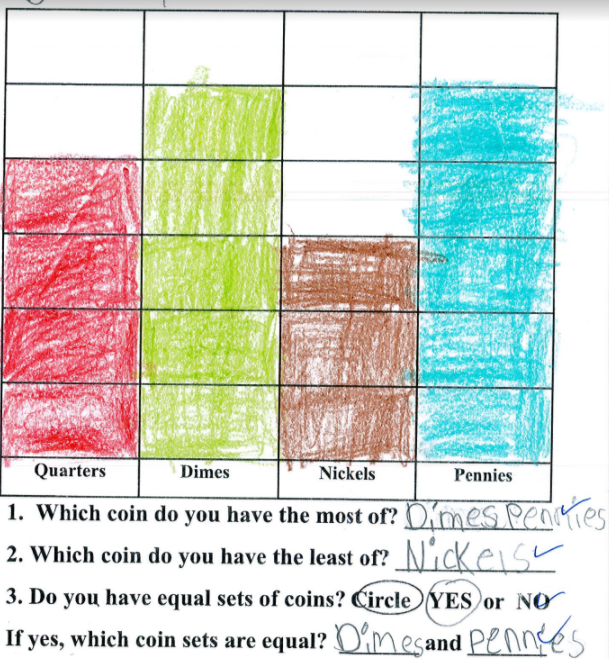- Author:
- DAWNE COKER
- Subject:
- Mathematics
- Material Type:
- Lesson, Lesson Plan
- Level:
- Lower Primary
- Tags:
- License:
- Creative Commons Attribution
- Language:
- English
- Media Formats:
- Downloadable docs
Education Standards
T4T Identifying Coins
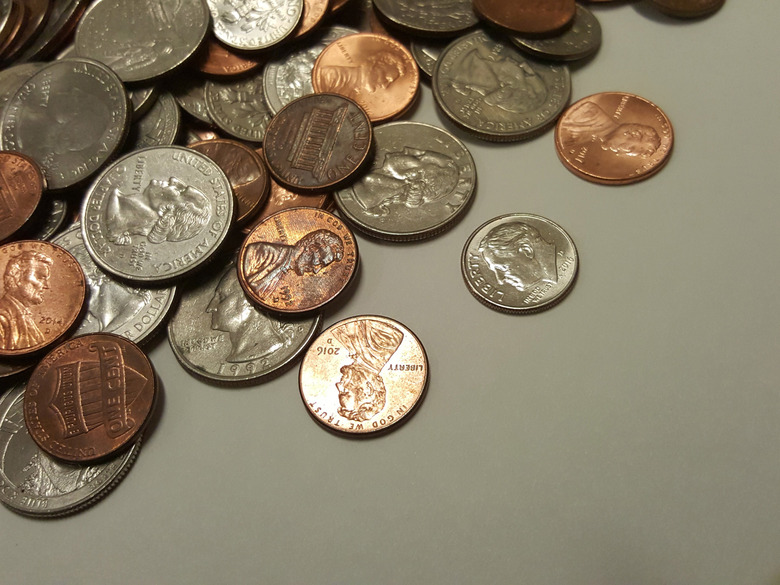
Overview
This resource is from Tools4NCTeachers.
In this lesson, students observe and describe the characteristics of a quarter, dime, nickel, and penny to help them identify and sort the coins. Students will also represent the number of each coin on a bar graph and will ask and answer questions to interpret the data. Student materials and photos of student work are included.
Remix this lesson to include extension ideas or additional pictures of student work.
Here is a sample of this resource. Click the attachment to download the fully-formatted lesson and support materials.
Identifying Coins
In this lesson, students observe and describe the characteristics of a quarter, dime, nickel, and penny to help them identify and sort the coins. Students will also represent the number of each coin on a bar graph and will ask and answer questions to interpret the data. |
NC Mathematics Standard:
Build understanding of time and money.
NC.1.MD.5 Identify quarters, dimes, and nickels and relate their values to pennies.
Additional/Supporting Standards:
Understand place value.
NC.1.NBT.3 Compare two two-digit numbers based on the value of the tens and ones digits, recording the results of comparisons with the symbols >, =, and <.
Represent and interpret data.
NC.1.MD.4 Organize, represent, and interpret data with up to three categories.
● Ask and answer questions about the total number of data points.
● Ask and answer questions about how many in each category.
● Ask and answer questions about how many more or less are in one category than in another.
Standards for Mathematical Practice:
- Make sense of problems and persevere in solving them.
- Reason abstractly and quantitatively.
- Construct viable arguments and critique the reasoning of others.
- Use appropriate tools strategically.
- Attend to precision.
- Look for and make use of structure.
Student Outcomes:
- I can describe the characteristics of a quarter, dime, nickel and penny.
- I can compare the characteristics of a quarter, dime, nickel and penny.
- I can identify and sort quarters, dimes, nickels, and pennies based on their characteristics.
- I can represent the number of coins on a bar graph and ask and answer questions about that data.
Math Language:
Money: Characteristics, Coin, Quarter, Dime, Nickel, Penny, Cents, Cent Symbol
Data: Sort, Category
Compare: Greater than, Less than, Equal to
Materials:
- 4 charts with a printed picture of coins taped in the center to create bubble maps
- Magnifying glass for each student to observe characteristics
- A bag of 15-20 assorted coins for each student—up to 6 of each type (You may want to give everyone the same amount of coins to help you determine correct answers later in the lesson. If different amounts of coins are used, you may photograph students’ sorts to determine if they completed their graphing activity correctly. You may choose to include two types of coins in the bag with equal amounts for students to discover.)
- A coin sorting mat for each student including the four categories: quarters, dimes, nickels, and pennies
- Copies of Graph and Compare activity sheet for each student to represent the number of coins on a bar graph and ask and answer questions about that data
- White board, dry erase marker and eraser for each pair of students for Mystery Coin
- A blank sheet of paper for each student to fold into fourths to complete the coin rubbing exit ticket
- A bag of 15-20 assorted coins of older and newer coins now in circulation. You will need a bag for each pair of students participating in this extension activity
- A copy of the Secret Coin Grid game board for each student participating in this extension activity
Advance Preparation:
- Print and display images of coins for students to reference throughout the lesson
- Gather materials as listed above
Directions:
- Close Up Coins (25 minutes)
Teacher will distribute a penny to each student. Students will use a magnifying glass to examine the characteristics on both sides of their own penny.
- What characteristics do you notice about a penny?
- What statements can you make about the characteristics of your penny?
The teacher will create a bubble map about the penny based on students’ ideas.
Teacher will distribute a nickel to each student. Students will use a magnifying glass to examine the characteristics on both sides of their own nickel.
- What characteristics do you notice about a nickel?
- What statements can you make about the characteristics of your nickel?
The teacher will create a bubble map about the nickel based on students’ ideas.
Make sure to relate the nickel’s value to pennies.
Teacher will distribute a dime to each student. Students will use a magnifying glass to examine the characteristics on both sides of their own dime.
- What characteristics do you notice about a dime?
- What statements can you make about the characteristics of your dime?
The teacher will create a bubble map about the dime based on students’ ideas.
Make sure to relate the dime’s value to pennies.
Teacher will distribute a quarter to each student. Students will use a magnifying glass to examine the characteristics on both sides of their own quarter.
- What characteristics do you notice about a quarter?
- What statements can you make about the characteristics of your quarter?
The teacher will create a bubble map about the quarter based on students’ ideas.
Make sure to relate the quarter’s value to pennies.
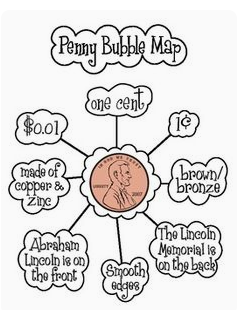

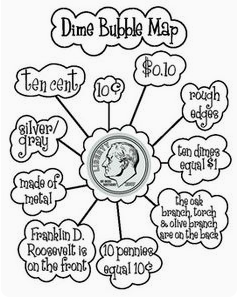
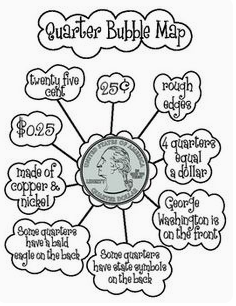
http://weclipart.com/bubble+map+clipart
Questions to ask partners to discuss after all bubble maps have been created:
- How are these coins similar?
- How are these coins different?
- What statements can you make about the characteristics of a penny that are different from the other coins?
- Mystery Coin (15 minutes)
Students will use what they know about the characteristics of each coin to ask a partner yes-or-no questions that will help them identify a coin. The teacher will explain to students that Partner 1 will secretly place a coin into their pocket. For Partner 2 to determine the name of the mystery coin, he/she can ask Partner 1 questions about the coins characteristics. Emphasize to students that they can only answer with yes or no. Once Partner 2 correctly names the mystery coin, they may switch roles.
Questions that could be asked:
- Is the edge of the coin smooth?
- Is the edge of the coin ridged/bumpy?
- Is George Washington on the front of the coin?
- Is the Lincoln Memorial on the back of the coin?
- Is it silver?
- Is it brown?
- Is it worth five cents?
*Remind students they may use the coin bubble maps to help them identify the mystery coins. Students may record the known information on a white board as they work toward the correct answers.
- Sort and Compare (10 minutes)
Provide each student with a bag of 15-20 assorted coins and a sorting mat.
Note: All students could have the same amount of each coin. If students use different coin sets, it may be helpful for students to take pictures of their sorts with an iPad to verify their graphs.
Students will sort the coins on the sorting mat by placing them in the appropriate category. Students will record the number of coins they have in each section of the sorting mat using numerals and/or tally marks. Then the students will pair up with a partner to ask and answer the following questions.
- What coin do you have the most of? How do you know?
- What coin do you have the least of? How do you know?
- Do you have any coins that have an equal amount? How do you know?
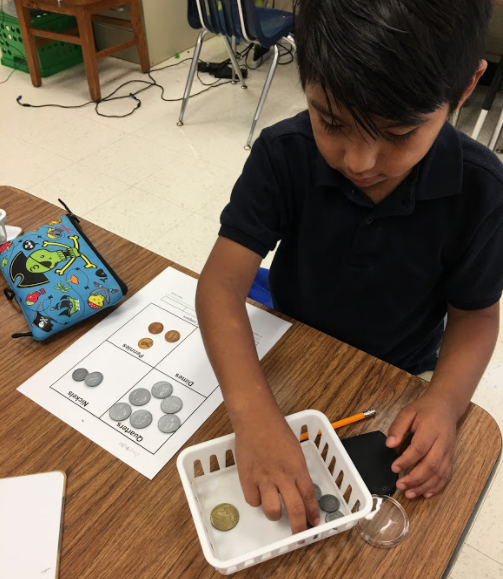
Evaluation of Student Understanding
Informal Evaluation:
Observe students describing the characteristics of each coin when examining with a magnifying glass. Also observe whether students are correctly answering the yes-and-no questions during the Mystery Coin activity. As students are sorting the coins onto their sorting mats, evaluate whether students are correctly categorizing the coins, especially nickels, dimes, and quarters. While students ask their partners comparing questions, evaluate students’ knowledge of the number of coins in each category, whether they are comparing sets of coins correctly, and specifying the equivalent value of each coin in pennies.
Formal Evaluation/Exit Ticket: (15 minutes)
Ask students to fold a blank sheet of paper into fourths. Then students will do a coin rubbing of each coin (front and back) in each section of the folded paper. Students will identify the name of the coins and list one characteristic of each that helped them determine the name of each coin. It may be helpful for the teacher to model how to do the coin rubbing and to allow partners to hold coins for each other while they do their rubbings.

Meeting the Needs of the Range of Learners
Intervention:
- Using real coins whenever possible will allow students to encounter characteristics that plastic coins cannot replicate: weight, textures, and the variations of quarters and nickels now in circulation.
- Have a reference card for students to use which includes an image of the front and back of each coin under coin’s name. Teachers could allow the use sentence frames to support students.
I have a ____. I know it is a ____ because____.
Some of characteristics of the________ are ______ and______. It is the same as___________ because____________.
The value of______ is ________. It is the equivalent of__________ pennies.
- Use Money Bubble Maps to focus on characteristics and academic language for one specific coin OR use them to compare and contrast characteristics and coin values.
- Students could complete the “Learn” part of the Learning Coins interactive lesson. http://www.abcya.com/learning_coins.htm
Extension:
- If students are successful with sorting and counting their number of coins in each set, students could complete the Graph and Compare activity. The teacher will ask students to represent their coins from the sorting mat on a bar graph. Students will work with partners to compare the numbers of each coin set they graphed on their activity sheets. Partners will ask and answer the following questions.
- Partner A: Who has the most pennies? How do you know?
- Partner B: Who has the most nickels? How do you know? How many pennies does it take to equal the value of a nickel?
- Partner A: Who has the most dimes? How do you know? How many pennies does it take to equal the value of a dime?
- Partner B: Who has the most quarters? How do you know? How many pennies does it take to equal the value of a quarter?
- Partner A: Do we have any coins that have an equal amount? How do you know?
- Challenge: What is the value of the money you graphed?
Once partners ask and answer the questions, students can independently answer questions about their own coin sets at the bottom of the Graph and Compare activity sheet.
- Allow students to determine their total money amount once all coins have been sorted and graphed onto the bar graph from the Graph and Compare activity.
- Ask students to explain what patterns they could use to determine the amount of money they have in each coin set and the total money amount of all coin sets: counting by ones, fives, tens, twenty-fives, or add ten more.
- Provide students with variations of older coins and newer coins that are now in circulation. Allow student pairs to spread out the coins so they can see them. Then ask students to sort the coins based on the characteristics they notice and explain how they sorted the variation of coins. (older coins vs. newer coins, copper coins vs. non-copper coins, etc.)
- Students could complete the “Sort” part of the Learning Coins interactive lesson. http://www.abcya.com/learning_coins.htm
- Students could play Secret Coins: Each player gets a Secret Coins Grid game board. Partners will sit facing one another and place a divider (book or folder) between them. Partner A will place coins on each section of their grid, making sure their partner cannot see where they place the coins. Partner A then provides instructions to their Partner B on how to place coins on their game board so that it will match. Students should use coins names and positional vocabulary to describe where their partner should place coins to match their game board. Partner A continues to provide instructions until Partner B has their entire game board covered with coins. Then the partners will remove the divider to compare game boards to determine how many of their coins match in the correct spaces. Partners then change roles and play again.
Possible Misconceptions/Suggestions:
Possible Misconceptions | Suggestions |
Students confuse the silver coins
| Provide ample time for students to examine the features of each coin and verbalize the differences. Use real coins whenever possible so students can encounter characteristics that plastic coins cannot replicate. |
Students confuse imprinted images and textures of each coin
| Interactively create an anchor chart for each coin including images (front/back) and characteristics |
Special Notes:
Teachers may choose to make bubble maps with students prior to this lesson. After two or more coins are introduced, the game Mystery Coin could still be used to practice.
Possible Solutions:
The characteristics students use to describe, identify, and compare coins may vary depending on the time of year the lesson is taught. Help students to make connections and learn to explain how many pennies relate to the value of the quarter, dime, and nickel.
Adapted from Hunovice, L., OConnell, S., & SanGiovanni, J. (2016). Teaching first-grade math. Portsmouth, NH: Heinemann.
Quarters
| Nickels |
Dimes
| Pennies |
Graph and Compare
|
|
|
|
|
|
|
|
|
|
|
|
|
|
|
|
|
|
|
|
|
|
|
|
|
|
|
|
|
|
|
|
|
|
|
|
|
|
|
|
|
|
|
|
|
|
|
|
Quarters | Dimes | Nickels | Pennies |
1. Which coin do you have the most of? _____________
2. Which coin do you have the least of? ______________
|
3. Do you have equal sets of coins? Circle YES or NO
If yes, which coin sets are equal? _______ and _______
Secret Coin Grid
|
|
| ||||||||||||||||||||||||||||||||||||||||||||||||||||||||||||||||||||||||||||||||||||||||||||||||||||||||||||||||||||||||||||||||||||||||||||||||||
Identifying Coins
NC Mathematics Standard: Build understanding of time and money. NC.1.MD.5 Identify quarters, dimes, and nickels and relate their values to pennies.
Additional/Supporting Standards: Understand place value. NC.1.NBT.3 Compare two two-digit numbers based on the value of the tens and ones digits, recording the results of comparisons with the symbols >, =, and <.
Represent and interpret data. NC.1.MD.4 Organize, represent, and interpret data with up to three categories. ● Ask and answer questions about the total number of data points. ● Ask and answer questions about how many in each category. ● Ask and answer questions about how many more or less are in one category than in another.
Standards for Mathematical Practice:
Student Outcomes:
Math Language: Money: Characteristics, Coin, Quarter, Dime, Nickel, Penny, Cents, Cent Symbol Data: Sort, Category Compare: Greater than, Less than, Equal to
Materials:
Advance Preparation:
Directions:
Teacher will distribute a penny to each student. Students will use a magnifying glass to examine the characteristics on both sides of their own penny.
The teacher will create a bubble map about the penny based on students’ ideas.
Teacher will distribute a nickel to each student. Students will use a magnifying glass to examine the characteristics on both sides of their own nickel.
The teacher will create a bubble map about the nickel based on students’ ideas. Make sure to relate the nickel’s value to pennies.
Teacher will distribute a dime to each student. Students will use a magnifying glass to examine the characteristics on both sides of their own dime.
The teacher will create a bubble map about the dime based on students’ ideas. Make sure to relate the dime’s value to pennies.
Teacher will distribute a quarter to each student. Students will use a magnifying glass to examine the characteristics on both sides of their own quarter.
The teacher will create a bubble map about the quarter based on students’ ideas. Make sure to relate the quarter’s value to pennies.
http://weclipart.com/bubble+map+clipart
Questions to ask partners to discuss after all bubble maps have been created:
Students will use what they know about the characteristics of each coin to ask a partner yes-or-no questions that will help them identify a coin. The teacher will explain to students that Partner 1 will secretly place a coin into their pocket. For Partner 2 to determine the name of the mystery coin, he/she can ask Partner 1 questions about the coins characteristics. Emphasize to students that they can only answer with yes or no. Once Partner 2 correctly names the mystery coin, they may switch roles.
Questions that could be asked:
*Remind students they may use the coin bubble maps to help them identify the mystery coins. Students may record the known information on a white board as they work toward the correct answers.
Provide each student with a bag of 15-20 assorted coins and a sorting mat. Note: All students could have the same amount of each coin. If students use different coin sets, it may be helpful for students to take pictures of their sorts with an iPad to verify their graphs. Students will sort the coins on the sorting mat by placing them in the appropriate category. Students will record the number of coins they have in each section of the sorting mat using numerals and/or tally marks. Then the students will pair up with a partner to ask and answer the following questions.
Evaluation of Student Understanding Informal Evaluation: Observe students describing the characteristics of each coin when examining with a magnifying glass. Also observe whether students are correctly answering the yes-and-no questions during the Mystery Coin activity. As students are sorting the coins onto their sorting mats, evaluate whether students are correctly categorizing the coins, especially nickels, dimes, and quarters. While students ask their partners comparing questions, evaluate students’ knowledge of the number of coins in each category, whether they are comparing sets of coins correctly, and specifying the equivalent value of each coin in pennies.
Formal Evaluation/Exit Ticket: (15 minutes) Ask students to fold a blank sheet of paper into fourths. Then students will do a coin rubbing of each coin (front and back) in each section of the folded paper. Students will identify the name of the coins and list one characteristic of each that helped them determine the name of each coin. It may be helpful for the teacher to model how to do the coin rubbing and to allow partners to hold coins for each other while they do their rubbings.
Meeting the Needs of the Range of Learners Intervention:
I have a ____. I know it is a ____ because____. Some of characteristics of the________ are ______ and______. It is the same as___________ because____________. The value of______ is ________. It is the equivalent of__________ pennies.
Extension:
Once partners ask and answer the questions, students can independently answer questions about their own coin sets at the bottom of the Graph and Compare activity sheet.
Possible Misconceptions/Suggestions:
Special Notes: Teachers may choose to make bubble maps with students prior to this lesson. After two or more coins are introduced, the game Mystery Coin could still be used to practice.
Possible Solutions: The characteristics students use to describe, identify, and compare coins may vary depending on the time of year the lesson is taught. Help students to make connections and learn to explain how many pennies relate to the value of the quarter, dime, and nickel.
Adapted from Hunovice, L., OConnell, S., & SanGiovanni, J. (2016). Teaching first-grade math. Portsmouth, NH: Heinemann.
Graph and Compare
1. Which coin do you have the most of? _____________ 2. Which coin do you have the least of? ______________
3. Do you have equal sets of coins? Circle YES or NO If yes, which coin sets are equal? _______ and _______ Secret Coin Grid
|
|
| ||||||||||||||||||||||||||||||||||||||||||||||||||||||||||||||||||||||||||||||||||||||||||||||||||||||||||||||||||||||||||||||||||||||||||||||||||
|
|
|
